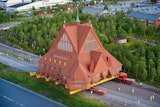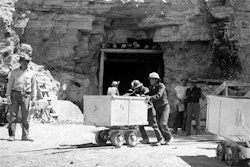Detroit’s Wastewater Treatment Plant is one of the largest in the United States, serving more than a third of Michigan’s population. The plant’s size and complexity are rooted in a convergence of three major forces: industry, water, and weather.
Aside from automobile production, the city is also synonymous with water: Its name comes from the river that runs through it, which French explorers called Rivière du Détroit and translates to “River of the Strait.” That strait – today’s Detroit River – leads to Lake Erie and the rest of the Great Lakes.
Like many of America’s urban waterways, the Detroit River and its tributaries were once badly polluted by raw sewage and storm water runoff. Construction of the city’s treatment plant in 1939 and a major series of expansions and upgrades over the next 50 years significantly improved effluent water quality.
But a major problem remained: Heavy rains and snow melts sometimes overloaded the treatment plant, allowing polluted storm water to run into the Detroit River and the connecting Rouge River. The Rouge –which lies at the center of a large watershed in the metro Detroit area – was so polluted by chemically laden runoff that the river caught fire in 1969.
To better protect the rivers from runoff, the city began building a network of combined sewer overflow basins 25 years ago. By capturing and substantially treating the storm water, the basins play a major role in protecting the surrounding watersheds, and the people and wildlife living there.
In just the first three months of 2011, for example, the basins collected more than 5 billion gallons of runoff that would have otherwise escaped into waterways. While a third was pumped to the main plant for treatment, the rest of that water was treated in the basins.
Challenge
Each combined sewer overflow facility differs somewhat in size and design, but all basically apply the same treatment process: retaining the overflow, mechanically screening out solids, and disinfecting the water with sodium hypochlorite (bleach). Basins also have equipment that operators use to monitor flow rate and volume, collect samples, remove residual water from the basins, and clean them after a wet-weather event.
Despite their similar functions, the basins’ process control instruments vary widely. From concept to commissioning, each basin required several years to complete because of strict municipal codes requiring public planning, open bidding and official oversight. Meanwhile, federal and state water quality standards were becoming more stringent, adding another layer of complexity.
“Through the years, we’ve had to update the process control systems at various basins to comply with changing regulations,” explained Anil Gosine, Process Control System Administrator for the Detroit Water and Sewerage Department (DWSD). The result is a “myriad of different process control systems at different locations. At one basin, we have process control equipment from four different vendors.”
Such a hodge-podge of legacy equipment makes integration difficult or impossible. “The lack of a standardized platform also hampers troubleshooting and maintenance,” Anil Gosine said. “Inventory is another problem, because we need to keep so many different spare parts on hand.”
Solution
In 2004, DWSD hired a consultant to design new, more effective and efficient control systems for two existing Combined Sewer Overflow Facilities. DWSD engineers specified Rockwell Automation as the vendor for the process control systems after performing a life cycle cost analysis.
The new system leverages the Rockwell Automation PlantPAx Process Automation System, which is an integrated control and information solution that combines capabilities of DCS with pervasive access to process information to help achieve plant-wide optimization. This scalable, multidiscipline platform helps users who need both process and sequential control to achieve lower total cost of ownership and a plant wide view.
System integrator Process Control & Instrumentation (PCI), LLC, was awarded the contract for replacement of non-functional control system instrumentation at two DWSD CSO Basins. PCI, a control engineering firm with an office in Detroit, worked with DWSD on other recent projects, giving PCI engineers a good understanding of the DWSD overall SCADA system.
But PCI faced a dilemma when it received the contract to retool the basins. The company had strategically offered the lowest bid to win the project with DWSD, as well as partner with Rockwell Automation for the first time. However, PCI engineers were concerned that the total cost of replacing the obsolete control systems would exceed the agreed-upon contract amount.
Rockwell Automation engineers recommended a solution that kept the project within budget – its PlantPAx Process Library and Water Wastewater Accelerator toolkit. The process library is an innovative software application for the Logix Control Platform that includes an array of pre-engineered code that can be used in various applications. It also incorporates custom faceplates based on specific plant roles, rich information-laden icons and full documentation.
The Water/Wastewater Accelerator toolkit customizes those elements to significantly reduce the time required to design, install, operate and maintain a wastewater project. The toolkit contains configured fi les, selection tools and examples of how to connect the Allen-Bradley ControlLogix controller to the facility’s human machine interface (HMI) hardware and other devices over EtherNet/IP and DeviceNet networks. The toolkit also provides system architecture drawings, basic status, control and diagnostic logic, as well as faceplates for FactoryTalk View Site Edition HMI software from Rockwell Automation used in the new Detroit basins.
The Rockwell Automation team on the project worked closely with PCI’s engineers on how to use the process library and the accelerator toolkit to custom configure the system for the Detroit basins.
“We needed to modify the toolkit to make the process data presentation familiar to DWSD operating folks,” the PCI engineer explained. “Some graphic faceplate elements didn’t align with DWSD’s color and naming conventions. For instance, they were used to seeing a red light when a piece of equipment was turned on, instead of the green light built into the process library. So we made that change and others that created a special standard toolkit just for Detroit.”
Results
The PCI engineer estimated that the process library and toolkit cut his work in half for both basins, saving around $120,000 in programming and systems-integration time. Another $90,000 was saved in factory-acceptance testing and startup/commissioning.
DWSD officials estimate the new tools from Rockwell Automation provided a 50 percent reduction in design time, contract oversight, and post-contract documentation and support.
“There’s a much shorter learning curve for the operators with the PlantPAx system,” said Gosine, who helped oversee the project for DWSD. “We also have access to a lot more data in an integrated format at these two basins. That has really improved the diagnostics, allowing more preventive and predictable maintenance.”
DWSD is in the process of standardizing two more basins with Rockwell Automation hardware and software, Gosine said. In the future, DWSD can make upgrades to the retrofitted basin controls using the process library, meaning engineers won’t have to completely recreate process standards and codes – saving even more time and money
The results mentioned above are specific to the Detroit Water and Sewerage Department’s use of Rockwell Automation products and services in conjunction with other products. Specific results may vary for other customers.
Allen-Bradley, ControlLogix, FactoryTalk and PlantPAx are trademarks of Rockwell Automation Inc. DeviceNet and EtherNet/IP are trademarks of ODVA. Trademarks not belonging to Rockwell Automation are property of their respective companies.























